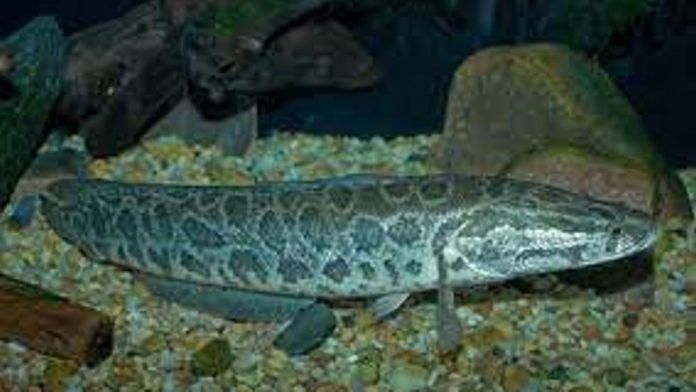New Delhi: The international trade in ornamental snakeheads — a group of multi-hued, carnivorous, aggressive freshwater fish — sourced from India has increased sixfold between 2014 and 2019, and now threatens to drive the species to extinction from national parks and sanctuaries in West Bengal and Assam, a team of researchers have revealed.
Known for their variety, many species of snakeheads remain unidentified, or have never been described in scientific literature.
Combining field observations with information contained in commercial export records, researchers from the University of Oxford in the UK and Gauhati University in Assam uncovered a booming trade in snakehead fish to meet a growing demand for exotic aquarium pets.
Using export records of live snakeheads from India, the team found a sixfold increase in the numbers of these freshwater species exported worldwide between 2014 and 2019, driven by an increase in exports from West Bengal to China, Taiwan, and Hong Kong.
The trade is dipping into protected stocks in national parks and sanctuaries like Buxa in West Bengal and Dibru-Saikhowa in Assam, with traders passing these off as legal harvest.
India has the highest diversity of endemic freshwater fish in continental Asia. However, none of the freshwater fish in India — with the exception of the pipefish — is included under any of the wildlife schedules of the Wildlife (Protection) Act, 1972.
The protection of freshwater fish in India is limited to national parks and sanctuaries, where the ‘removal of wildlife’ is not permitted under the Act, and to ‘reserved forests’, where fishing is prohibited under Section 26 of the Indian Forest Act, 1927.
Also read: On World Wildlife Day, a look at some of India’s success stories
‘Species may be extinct before we know they exist’
Being among the few fish species that are able to breathe air and survive out of water for a length of time, many snakeheads thrive in swampy habitats and are potentially invasive.
For example, the Bullseye snakehead (Channa marulius) has invaded rivers and swamps in Florida and some other US states, leading to an import ban in the US.
Among the 21 formally recognised snakehead species found in India, at least 19 are in demand in the aquarium trade. All of these are sourced from the wild, with no control over their harvest or trade.
“There is a real risk that the exotic pet trade may threaten snakehead fish survival. Some of these high-in-demand species are thought to be extremely rare and occur only in very restricted ranges,” Dr Lauren Harrington of the Wildlife Conservation Research Unit (WildCRU) of the University of Oxford and lead author of the study said in a statement to ThePrint.
Harrington said that for most of the species involved, there is little, if any, information on their population status or distribution, which means that the risk of overharvest is impossible to predict or manage.
“The situation is especially difficult because of the complex taxonomy of snakeheads — we don’t even know exactly how many species there are, meaning that a species may become extinct before we even know that they exist and are scientifically described,” she added.
“The lack of key data on wild populations, together with the recent spike in trade volume, is a serious conservation concern,” she further said.
Huge profits, snakeheads poached from protected areas
Researchers gathered additional information on the harvest of snakeheads during fieldwork in Assam and West Bengal. The team visited fishing sites and local markets, and met fishermen and traders who gather the catch and forward it to exporters in Kolkata.
They found that collection of snakeheads from the wild is carried out all year round, with peak activity during the monsoon, when these species are at their “colourful best and breeding”.
Depending on the species, fishermen catch snakeheads from all aquatic habitats, from fast flowing hill streams to lowland swamps, using a range of traps and fishing gear.
Methods used include nets, bamboo traps, plant poison and even mild electric shock to stun the fish. In some cases, muddy soil is heaped to channel water away and expose snakehead burrows so they can be captured by hand.
“We used intelligence gathered from commercial trade records to work our way down the trade chain right to the very source. Fishers at the bottom of the trade chain told us that some, like the Golden cobra snakehead, can fetch more than five times the price of snakeheads that are sold for food,” said Aniruddha Mookerjee, consultant wildlife advisor at WildCRU.
“It seems that the profits involved are so enticing that they lead to illegal activity…we were shocked to find that snakehead fish were being poached from protected areas including Buxa and Dibru Saikhowa National Park,” he added.
Minakshi Kalita, a researcher at Gauhati University, gives a concrete example to illustrate the point.
“In particular, we were extremely concerned to find that the Barca snakehead, which is highly priced in the aquarium market, may have become so difficult to come by outside of national park borders that the fishers are daring to source them within these protected areas,” she said.
While freshwater fish provide an important food source, the increase in catch for the aquarium pet trade suggests that review legislation targeting snakehead fish harvest is needed, the team of researchers said.
(Edited by Saikat Niyogi)
Also read: Fishing industry suffers another blow as workers are stranded on boats, debt is piling up



